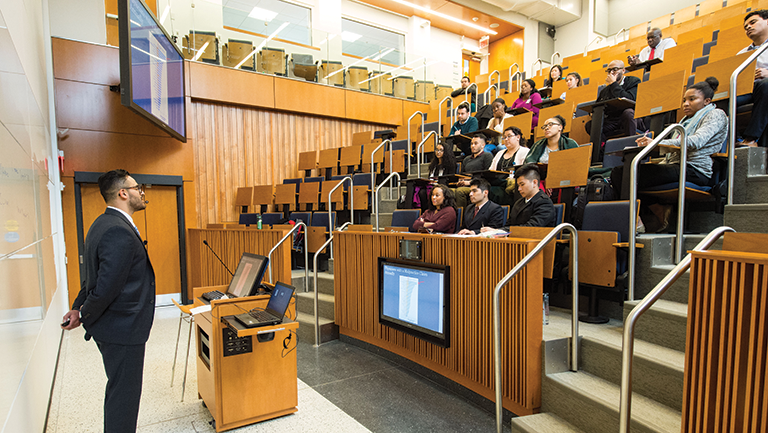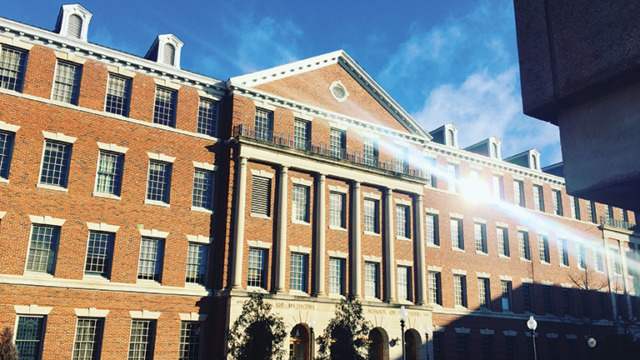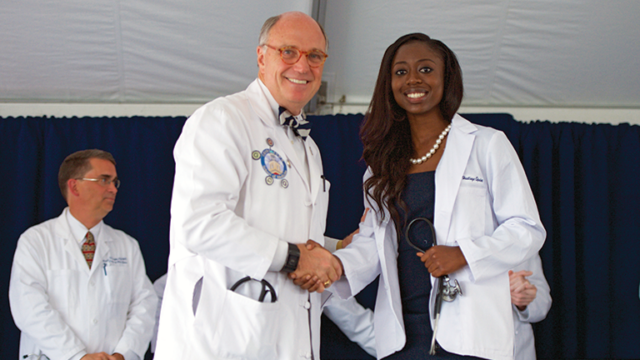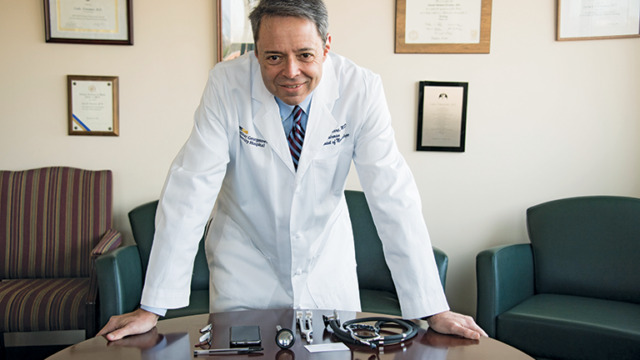
Title:Fulfilling Dreams, Serving Others
When Jeremy Raider Estrada (M’09) looks back on his journey to becoming a physician, he speaks with passion about the key to unlocking his dream: “Education is the reason I was able to become who I am.”
He grew up in a rough neighborhood in Los Angeles. Gang violence marred much of his early years, claiming the lives of his best friend and others close to him. He too joined a gang at a young age and landed in the juvenile justice system. While there, the care and attention of a mentor sparked Estrada’s love of learning—and turned his life around. He threw himself into his studies and emerged a young man dedicated to serving others, eventually working for the city of Los Angeles counseling gang members and their families.
Counseling was challenging, rewarding work—but not Estrada’s dream. Having discovered a love for biology, he dreamt of becoming a physician. However, he had a young daughter and family to support and considered it unrealistic.
They lived in a one-bedroom apartment in an area with persistent gang violence and poverty. One evening, his threeyear- old daughter Angelica fashioned their closet into a “fortress,” her cozy place to escape and play. Estrada crouched down and crawled into the tight space to join her for story time. Tonight’s choice: Oh the Places You’ll Go! by Dr. Seuss.
He read her the story about chasing dreams, encountering life’s challenges, and finding joy and meaning for oneself. Suddenly Angelica asked, “Daddy, what did you want to be?”
“A doctor,” he said.
“Well why aren’t you a doctor then?” she replied.
While his current job was meaningful, he thought, “We’re living in South-Central Los Angeles, making ends meet, hearing gunfire at night. This is not what I want for my daughter.” In that moment, he decided to return to school full-time— while still working full-time—to pursue the grades and MCAT scores that would qualify him for medical school.
“I wanted to set an example for my daughter—I call her ‘my heartbeat’ to this day—to endlessly pursue your goals, no matter what,” he says.
Estrada eventually applied to over 40 medical schools. With modest grades and scores, he was admitted to two, but another option drew his interest: acceptance into the Georgetown Experimental Medical Studies (GEMS) program. The yearlong post-baccalaureate program prepares students from disadvantaged backgrounds for the rigors of medical school. GEMS identifies students who traditionally might not be accepted into medical school due to lower scores, and helps them build the knowledge and skills necessary to excel as physicians.
Estrada enrolled in GEMS. After the intense one-year program, he was accepted to Georgetown University School of Medicine. He flourished at Georgetown, and credits the university with changing his life. After completing his residency and fellowship at the University of Chicago, today he is an interventional cardiologist in Portland, Maine. He now has his dream job, he says, serving others and living out his passion for medicine and cardiology.
GEMS made all the difference, Estrada says.
Learning to learn
The program provides students with a solid foundation of scientific and medical knowledge, notes David Taylor, GEMS director and associate dean for student learning. More importantly, he adds, it equips them with the learning strategies needed to be successful through medical school and as physicians. This often means overcoming old study habits such as cramming, procrastinating, and rote memorization.
Recent GEMS alumnus Rui Soares (M’20) calls it “learning how to learn”— how to acquire, assimilate, and apply knowledge to real-world situations. Success in medical school depends on developing a study plan and devoting time to not only learn the content but to test, question, and use it.
And in GEMS, teach it.
One of the signature GEMS educational techniques, the facilitated session, requires students to stand before a classroom of peers and teach a topic in medicine. Tamika Auguste (M’00, R’04) vividly remembers the first one she led, during her first week in GEMS over 20 years ago.
Asked to teach the Krebs cycle in biochemistry, she stepped up to the board confident she knew enough to succeed. “I ended my lecture when I came to the end of my knowledge of the Krebs cycle,” she says. “But that was not good enough for our facilitator, Dean Taylor.”
Taylor challenged her to go deeper.
“But I’m thinking: I don’t know any more!” recalls Auguste. “I was standing at the board and I so wanted to sit down. Dean Taylor pushed me to think through what I did not know. My colleagues in the room—my other GEMS classmates— spoke up to contribute their knowledge. With their help, I got through it.” A hallmark of GEMS, the shared struggle means students learn together, face defeat together, and triumph together.
“It was one of the most difficult and vulnerable points I had ever experienced in my academic career,” Auguste says. “I remember thinking: I don’t belong here.”
Today she is associate professor of obstetrics and gynecology at the School of Medicine, and associate medical director for OB/GYN at the MedStar Health Simulation Training & Education Lab.
Like many GEMS alumni, she describes the rigorous program as the most difficult time in all her years of education. GEMS participants spend most hours of most days together in an intense learning and mentoring environment.
“At the end, if you follow the plan, you are amazed at your own transformation,” Auguste says. “And then you look around and you see who you transformed with, and that bond is unbreakable.”
40 years in the making
In addition to facilitated sessions, GEMS students take medical school courses alongside first-year medical students and are required by the program to perform as well as or better than the average first-year. As a result, when applying to medical school, GEMS alumni can prove their academic readiness.
School of Medicine faculty members Arthur Hoyte and Heinz Bauer founded GEMS in 1977. They sought to identify students from populations underrepresented in medicine who demonstrated potential to make contributions to the field. After just two years, the School of Medicine formalized the program and hired coordinator Joy Phinizy Williams, who eventually became senior associate dean and served at Georgetown for 35 years. GEMS alumni describe her as a mother figure and a reason they came to Georgetown.
Taylor joined the program’s team in 1990 and is similarly described as a father figure. He and Williams shaped GEMS into the program it is today, one marked by high academic standards and a collegial atmosphere.
Of the more than 700 students who have attended GEMS since its founding, 75% are now physicians, current medical students, or medical school applicants. For the past decade, GEMS cohorts average 21 students per year. The majority end up matriculating at Georgetown School of Medicine, with a handful attending other medical schools. Since 2005, GEMS alumni pursuing an MD have graduated from medical school at a near perfect rate of 98.6%.
Numbers tell only part of the story
“GEMS is Georgetown’s effort to look for potential success that is yet to be tapped,” explains Taylor. “It goes back to the Jesuit principles of partnering with and empowering those who’ve been underserved and disenfranchised.”
Statistically, applicants with higher GPAs and MCAT scores are more likely to be successful in medical school, he notes. However, there’s a subset of students for whom the numbers tell only part of the story.
“Being an outstanding physician is about more than academic success,” Taylor says. “Georgetown has been very good at identifying students who will benefit from an educational intervention, when modest scores do not reflect their true abilities.”
GEMS seeks to provide an opportunity for those students to grow into their full potential as medical professionals. The proof is not only in the program’s high rates of success for its graduates, but in the diverse perspectives, experiences, and passion that GEMS alumni bring to medicine and to the communities they serve.
Expanding the impact
While GEMS is life-changing for alumni, its impact is amplified through their service.
Sean Morgan (M’13) grew up in a struggling community in West Philadelphia. In his teens, he worked as a lifeguard. Whenever he had to call an ambulance, he would admire the work of the responding emergency medical technicians. Morgan became an EMT—a position he held through college. Later in his medical training, working closely with emergency medical professionals, he thought about his longer-term career goals and envisioned bringing emergency care to the field. After he became an emergency medicine attending physician, he proposed his vision to the local EMS community: to serve as a doctor working on an ambulance.
“There’s a saying in emergency medicine,” he says, “that we want to bring ‘upstairs’ care ‘downstairs.’ It doesn’t matter if someone is sitting in a busy emergency department waiting to go upstairs; they should be able to get the best care available while still in the ED. I wanted to expand that and bring quality emergency department care to the field.”
Morgan currently serves as an assistant director of EMS at Geisinger Community Medical Center, and deputy medical director of an ambulance service in Scranton, Pennsylvania.
The physician-staffed response unit is the first service of its kind in Northeast Pennsylvania. Morgan’s drive to make the program a reality reflects his desire to find the needs in his community and meet them. “The goal is for the program to grow beyond this area, with other doctors jumping on board. We hope that our EMS model works here and will translate to other parts of the country as well,” he says.
“A lot of what I do in emergency medicine today draws from the basic sciences and the foundation I built in GEMS. The program works and we’re all living testaments to it,” he says, nodding to both the academic and professional mentorship he received.
Morgan’s approach to service was also shaped by his time at GEMS and at Georgetown School of Medicine—and by his personal upbringing. He says that his background, like that of his GEMS peers, influenced his commitment to serve others at the margins of society.
“We grew up poor, we grew up in situations that were not ideal, and we have a different sense of what life is like,” he says. After graduating medical school, he adds, “I couldn’t in good conscience do what I do and forget about where I came from. Where I came from built me. I wouldn’t be the physician I am today if I didn’t have the struggles I had faced.” He says it motivates him to spend time understanding and connecting with each of his patients, to do more than just collect a paycheck. To serve.
Impact on research
Through alumni who work in research and policy, GEMS reaches beyond local communities to impact the national stage.
In the Agency for Healthcare Research and Quality at the U.S. Department of Health and Human Services, Francis Chesley (C’83, M’88, R’91) oversees a research grant program as well as career development and training for future health services researchers. He also conducts intramural research.
He looks back at his time in GEMS as formative for his career. The nurturing program, he remembers, was dedicated to bringing more diversity to the School of Medicine. Along with the program’s mentorship and camaraderie with his peers, he says he especially appreciates the curriculum’s exploration of prevailing disparities in health and health outcomes based on race, ethnicity, and socioeconomic status. Learning about the presenting symptoms and outcomes for patients, as well as the social determinants of them, shaped how he now approaches medicine as a researcher.
“I wanted to understand the basic etiology of diseases and how those diseases manifest in different people,” Chesley says. “I felt the frustration of not having information that was sufficient across a broad and diverse group of people, so I began to think about how to include a more diverse patient population within clinical studies to produce evidence that would be applicable across all populations.”
Recent GEMS graduate Soares shares this interest in understanding the social determinants of health—an interest fueled during his GEMS year.
“In GEMS, you not only learn about medicine and the data you need to understand as a physician,” says Soares. “You learn about the broader factors that affect health—our surroundings, our environment, our society as a whole. What plagues our society? What are the social injustices that are occurring in this time?”
Building cultural competency
Medical schools across the nation recognize that a more diverse student body helps to cultivate greater cultural competency across the profession, and prepares a physician workforce better able to serve a diverse population. While gains have been made in certain areas—for example, among minorities more young women are practicing medicine than ever before—other demographics have not fared as well. According to the Association of American Medical Colleges (AAMC), African Americans account for just four percent of the physician workforce even though they represent 13 percent of the U.S. population. Individuals from economically disadvantaged backgrounds remain underrepresented in medicine, with a majority of all medical school matriculants in 2015 coming from families making more than $50,000 per year. When broken down by race, African American, Hispanic, and Asian matriculants are more likely than their peers to have parents who make less than $50,000.
Caridad Maylin de la Uz (M’05) spent the first few years of her life in a small “dirt road town” outside Havana, Cuba. Her family boarded a shrimp boat to come to the United States as part of the 1980 Mariel Boatlift. Today a pediatric cardiologist and electrophysiologist at Texas Children’s Hospital in Houston, de la Uz focuses her clinical care and research on implantable cardiac electronic devices, helping patients and their families cope with medical challenges.
Her lifelong dream to become a physician was born in Cuba. She remembers the important role her local doctor held in the community. She also recalls a young friend who had a severe form of cerebral palsy. She would watch television next to him and his medical equipment while their families visited.
“To this day, I can remember the unnerving mix of fear, sadness, pity, and curiosity that overcame me every time I was with him,” she recalls. She didn’t understand his condition but wanted to, and this curiosity inspired her to eventually study pediatrics.
These early memories, along with her experience growing up in an immigrant family with limited resources, helped shape her into a compassionate physician. She recalls her time at GEMS as essential to her formation. “We were taught to value the individual. We were taught the importance of cultural, religious, and ethnic diversity and how to—even if unfamiliar with it—be respectful and inquisitive. We learned this starting in the GEMS program. We all came from different backgrounds,” she says, some with economic or personal hardship, others with language barriers or learning disabilities. “Yet, we became a family. We learned tolerance and respect for one another and our differences.”
This lesson was also broadened to patient care during her time at Georgetown. Calling on the Jesuit principle of cura personalis, she notes, “Disease does not live in isolation. Disease is within a person, a family, a culture, a faith, a community. You can’t just treat the disease—you have to go beyond it to understand the context in which you’re treating a person.”
Nationally, this means educating physicians who can understand and connect with a changing population. “The GEMS program adds to the pool of diverse medical professionals so it’s a better reflection of the people we serve,” she says.
Auguste echoes this sentiment.
“Medicine today is different than medicine 25 years ago,” she says. “Our world is changing. Our cultural competency is essential to how we take care of our patients. We have patients from different parts of our town, our state, our country, our world coming to receive care from us, with different cultural norms. We have to be aware of this in order to deliver the best care.”
For de la Uz, the importance of cultural competency comes down to a trusting therapeutic relationship. “It’s essential to be able to make your patient feel valued, welcome, and safe.”
In her pediatric cardiology practice, for example, she works with Jehovah’s Witness families who refuse blood transfusions. “Instead of being critical, we need to be creative and say, ‘How can we help your child go on bypass to get this critical surgery? We’re going to work with you.’ You have to be able to let your patients know that you respect their differences and you’re willing to work within those differences to achieve good medical results.”
Looking back, Estrada sees the effect of GEMS on the way he treats his patients today.
“In my profession, when someone comes in with a heart attack and requires a stent, their previous medical compliance, their use of drugs, their medical follow up all determine what type of stent to put in,” he says. “My participation in the GEMS program, and what I learned as a medical student at Georgetown, guide me to give people the benefit of the doubt, give people second and third chances, take people for what their intentions are and what their hopes are, rather than make blanket assumptions or judgments based on previous experiences.”
In addition to the professional impact, Estrada notes that GEMS classmates form strong and lasting personal relationships. “We all keep in touch,” he says. “My GEMS classmate Vern Fennell (M’09) is still my best friend, and he was the best man at my wedding.”
And speaking of weddings…
“Oh, and I met my wife Gladys in GEMS!” he quickly adds with a laugh. “Should have mentioned that first.”
For more information on the GEMS Program visit https://som.georgetown.edu/diversityandinclusion/gems.

“We all know sunlight provides vitamin D, which is suggested to have an impact on immunity, among other things. But what we found is a completely separate role of sunlight…

The inaugural Dr. Katy Roth Scholarship at Georgetown University School of Medicine has been awarded to Lindsey Hastings-Spaine (M'19).

Georgetown neurologist Carlo Tornatore (MS'82, M'86, R'90) carries seven essential items in his white coat pockets.